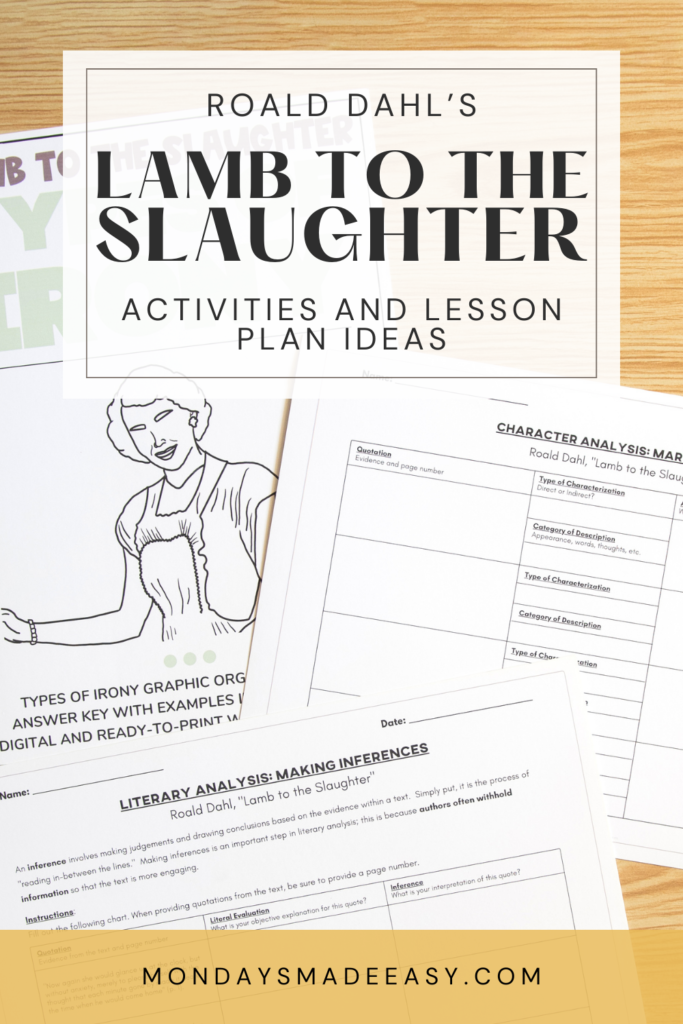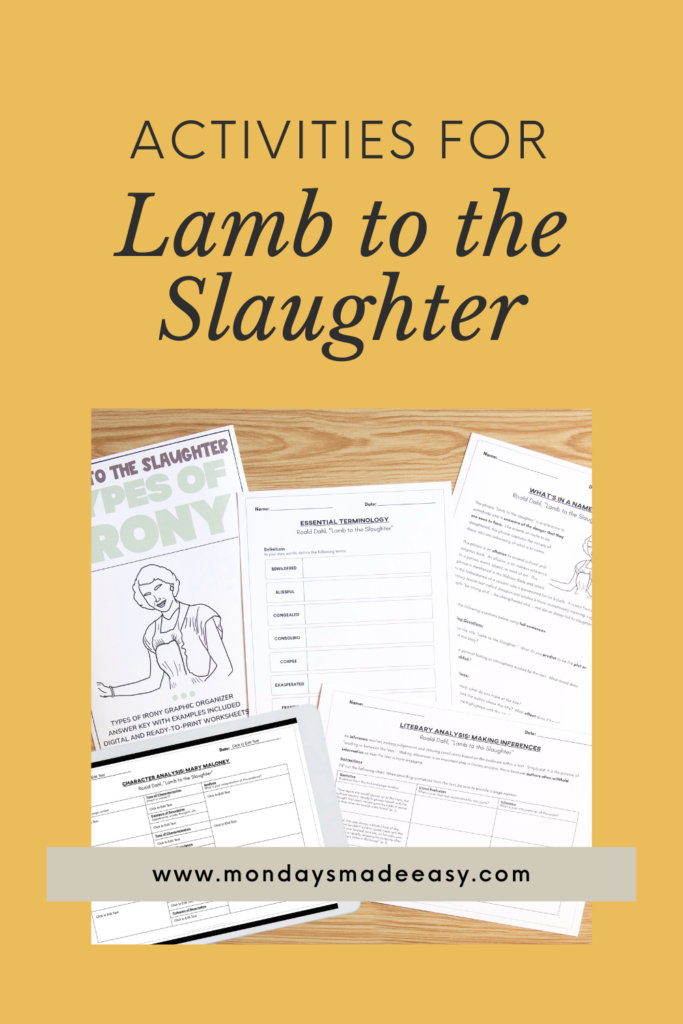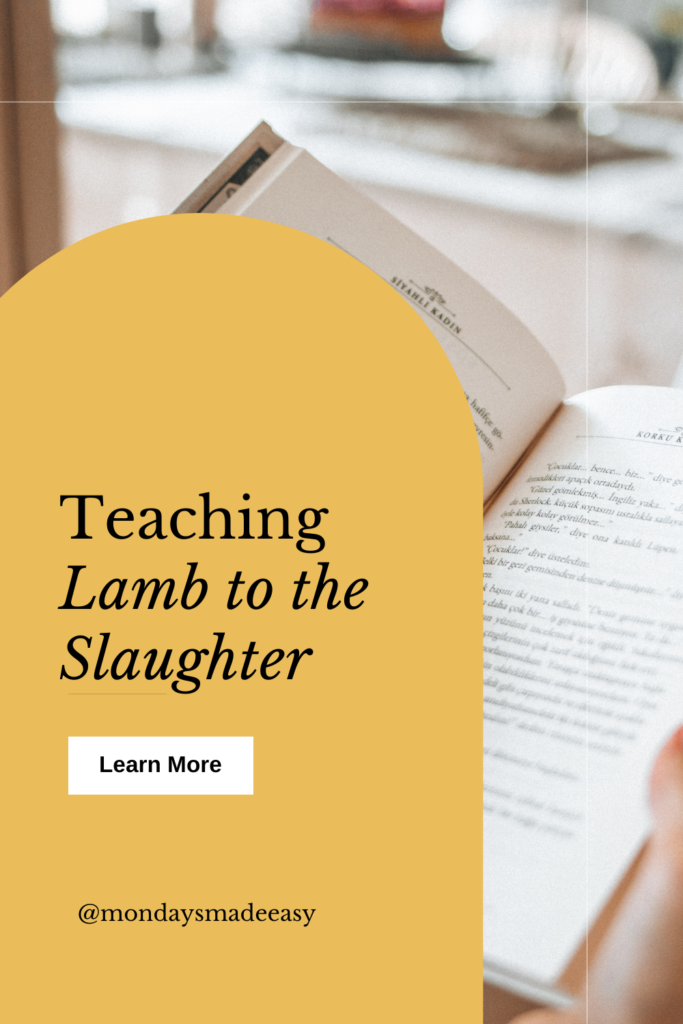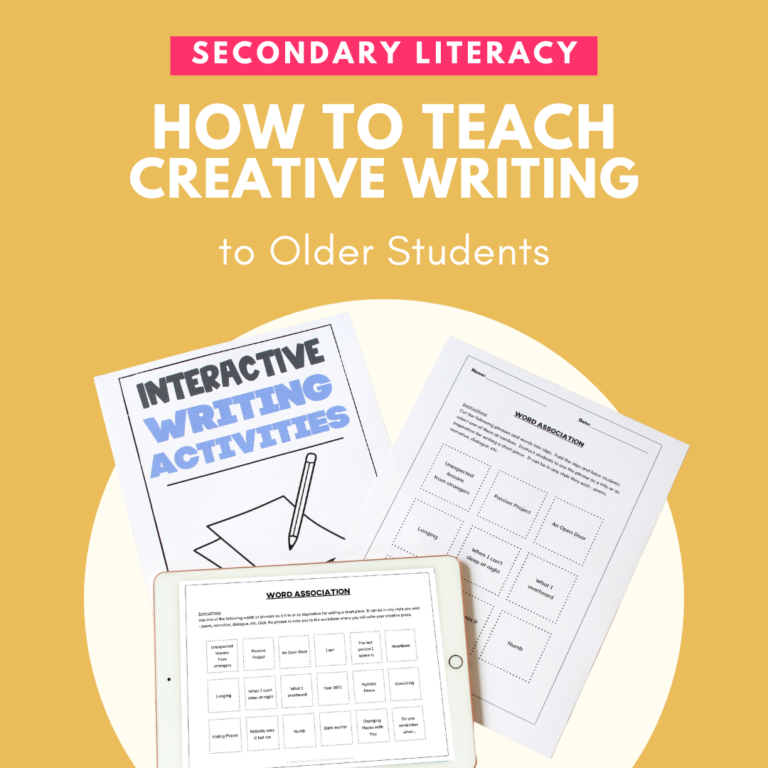“Lamb to the Slaughter” is a timeless classic. Roald Dahl’s brilliant short story uncovers a plot that is equal parts suspenseful and darkly humorous. Set in what appears to be an ordinary domestic scene, Dahl masterfully weaves a tale of deception, revenge, and unexpected twists. There is no shortage of activities for teaching “Lamb to the Slaughter” in your classroom.
This short story is sure to engage your students and leave them with plenty to discuss. It’s also a great option for teaching irony, making inferences, and exploring characterization. If you’ve never taught “Lamb to the Slaughter” before, prepare to have students at the edge of their seats!

What is “Lamb to the Slaughter” About?
When a devoted housewife receives startling news from her husband, this seemingly congenial story takes a dark and unexpected twist. Roald Dahl’s scary short story is a tale of ingenuity and the ironies of justice. With a weapon as unusual as it is ordinary, Dahl masterfully uncovers the thin line between love and vengeance. Your students will learn that there’s more that meets the eye after reading this eerie classic!
The story revolves around the protagonist, Mary Maloney – a traditional housewife with less conventional problem-solving skills. Unforeseen events suddenly disrupt Mary’s world, leaving her with a lot on her plate. As the narrative progresses, a profound transformation takes place, reshaping the course of her life. Dahl’s masterful storytelling skillfully navigates themes of tension, suspense, and human nature. It offers students a gripping and thought-provoking exploration of the character development and plot twists.
What age is “Lamb to the Slaughter” suitable for?
“Lamb to the Slaughter” is just about 4000 words in length. With a Lexile level of 780, this scary short story is suitable for sophomores, freshmen, and even students in upper middle school.
If you teach senior-level high school students, “Lamb to the Slaughter” is still a valuable short story for your classroom. Students with a mature understanding of the culture of domesticity will have a lot to unpack from the story. Students can practice argumentative writing through exploring the motivations of Mary Maloney using these essay prompts.
It is important to note that “Lamb to the Slaughter” is a short story that implies a fair bit of violence. Although the events of the story are intended to be interpreted on a symbolic level, these events may be unsettling for some students. Educators should exercise discretion and consider the maturity and sensitivity of their students when choosing to include this story in a classroom curriculum.

What is the main lesson of “Lamb to the Slaughter?”
“Lamb to the Slaughter” illustrates how seemingly ordinary people can react in extraordinary ways when pushed to their limits. It serves as a commentary on the complexities of human behavior, the unpredictability of life, and the consequences of impulsive actions.
This short story is also a great starting point to exploring more complex concepts like implicit bias, domestic violence, and the criminal justice system.
Activities for teaching “Lamb to the Slaughter”
When it comes to short stories, I like to dig deeper into the themes and ideas that arise. Short stories provide a lot of value to the classroom because they spark engagement without assigning too much reading for homework. The other benefit of short stories is that they provide a less intimidating text to encourage close reading. I like to spend at least a week teaching “Lamb to the Slaughter” – sometimes even two. This offers students the opportunity to really master the text and revisit it enough to gain a deeper understanding.
Here are my favourite lessons and activities for teaching “Lamb to the Slaughter”:
1. Practicing Making Inferences
What is remarkable about this short story is how much of it is told between the lines. Students will have to make inferences about this story regardless of whether you prompt them to or not. In order to come to grips with the central event of the story, they’ll have to make conclusions based on the clues provided by the author.
I like to use this learning opportunity to teach students about making inferences. This graphic organizer will prompt students to make inferences and dive deeper into an analysis of Roald Dahl’s “Lamb to the Slaughter.” Students will be challenged to analyze evidence from the text to provide both a literal evaluation and an inference about the interpretive meaning of each quote. There are 11 quotations from “Lamb to the Slaughter” in total. Each quotation highlights key moments within the short story. These include the motivations of each character and the missing dialogue between Patrick and Mary.
Your lesson on making inferences can also serve as a pre-reading activity using this informational handout about “Lamb to the Slaughter.” This handout explains the origins of the title of this short story and prompts students to make predictions about what will happen. To consolidate this activity, this handout also includes pre-reading and post-reading questions to evaluate Dahl’s choice of title.
The missing dialogue between Patrick and Mary is truly the most mysterious and intriguing aspect of “Lamb to the Slaughter.” My students have had a lot of fun responding to a narrative writing prompt that has them explore the possible exchanges that can fill the void that Dahl creates in this story. This narrative writing assignment is also a great way to consolidate your lesson on making inferences.

2. Exploring Characterization
“Lamb to the Slaughter” is an excellent resource for teaching characterization in literature. Through the transformation of the protagonist, the story offers a compelling case study in character development. Educators can guide students in exploring how the author uses direct and indirect characterization techniques to reveal Mary Maloney’s personality, motivations, and internal conflicts.
By dissecting Mary’s actions, thoughts, and dialogue throughout the story, students can gain a deeper understanding of the complexities of character construction and how authors employ various literary devices to bring characters to life.
This character analysis informational handout defines characterization and differentiates between direct characterization and indirect characterization. Students will then be prompted to locate evidence in the text to characterize Mary Maloney, Patrick Maloney, Jack Noonan, and Sam.
Students can organize their evidence from the text in this character analysis graphic organizer. This graphic organizer prompts students to identify the type of characterization (direct or indirect characterization) and the category of characterization (words, thoughts, appearance, etc.). Finally, students will also analyze the evidence to offer their interpretation of the character.
3. Identifying Types of Irony
“Lamb to the Slaughter” is one of my favourite stories to use to demonstrate different types of irony. Students can explore how Dahl composes a story in which the title itself takes on a profound irony. As the story unfolds, the seemingly mundane domestic setting is juxtaposed with the shocking events that transpire, providing an ideal backdrop for discussions on this literary device. In addition to this, the unexpected twists in the plot – along with the reactions and perceptions of the characters – offer rich material for exploring dramatic irony.
Analyze Dahl’s brilliant use of irony with this free irony flow chart. This worksheet defines irony and differentiates between dramatic irony, situational irony, and verbal irony. Students will be prompted to locate evidence in the text to apply examples to teach type of irony. They will also analyze why these examples qualify as ironic.

4. Teaching Argumentative Writing
If you teach older students, they’ll definitely have some fun arguing about the motivations of Mary Maloney. By interpreting her actions on a symbolic level, senior students can even analyze “Lamb to the Slaughter” from a feminist lens, and respond to whether or not Mary is a revolutionary housewife.
This argumentative writing assignment for “Lamb to the Slaughter” provides three argumentative essay prompts. You can select a single writing prompt to assign to your students, or provide them with the option of student choice. These prompts assess students on different areas of literary analysis, including figurative language (specifically irony), characterization, and theme.
For a more experiential approach, you could also host a mock trial for Mary Maloney. This project-based learning opportunity provides differentiated roles for your students. It will help them develop main points and evidence to support their cases. If you have a particularly inquisitive group of students, you can assign them the task of defending Mary Maloney on whatever grounds they can imagine. Temporary insanity or lack of sovereignty are two arguments that can create a compelling case!
Teaching Lamb to the Slaughter: Tying It All Together
There are so many fun lessons and activities for teaching “Lamb to the Slaughter.” Whether you teach middle school or senior students, there is so much value to be found in this short story. I hope you’ve found this blog post offered you some engaging options! To take your exploration of this classic short story to the next level, make sure to check out this “Lamb to the Slaughter” unit from my shop.




